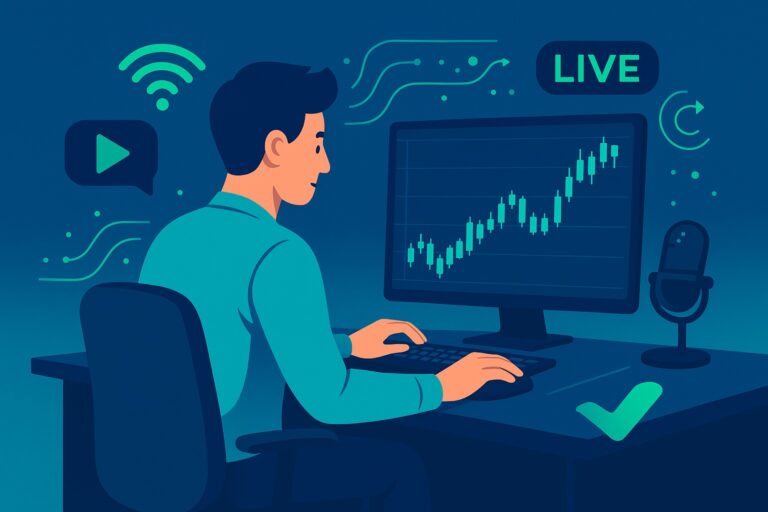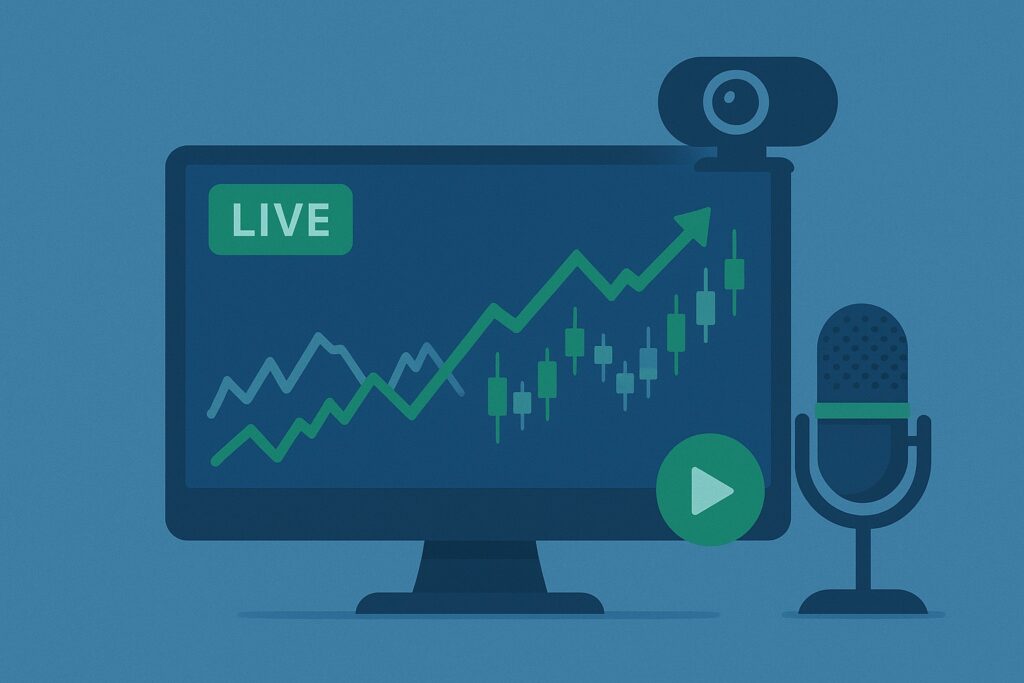
What Is Live Trading? Understanding Real-Time Trading Streams in 2025
Have you ever wondered whether that trading guru on social media actually makes the profits they claim?
Or questioned if those impressive trading screenshots are real?
The answer to building trust in the trading world might be simpler than you think: live trading.
Live trading has emerged as the gold standard for transparency in trading education.
When mentors trade live, they provide real-time proof of their strategies, decision-making process, and actual results.
No edited screenshots, no cherry-picked trades, just raw, unfiltered trading in action.
Whether you’re considering following a trading mentor, starting your own educational platform, or simply curious about what live trading entails, understanding this concept is crucial for navigating today’s trading education landscape.
What Is Live Trading?

Live trading refers to executing real trades with actual money in real-time, typically while being observed by others through streaming platforms, screen sharing, or specialized trading platforms.
Unlike paper trading (using fake money) or sharing results after the fact, live trading happens in the moment with immediate, verifiable outcomes.
Key characteristics of live trading include:
- Real money at risk: Traders use actual capital, not demo accounts
- Real-time execution: Trades happen live, not pre-recorded
- Transparent process: Viewers can see the entire decision-making process
- Immediate results: Profits and losses are visible instantly
- Interactive element: Often includes real-time commentary and Q&A
Live trading serves multiple purposes: education, entertainment, verification of trading ability, and community building. For trading mentors, it’s become an essential tool for proving credibility and teaching practical skills.
Types of Live Trading

1. Educational Live Trading
Purpose: Teaching trading concepts through real-time application
Features: Detailed explanations of strategy, risk management, and decision-making entertainment value
Audience: Students learning trading fundamentals and advanced techniquesnced techniques
2. Entertainment/Content Live Trading
Purpose: Creating engaging content for social media or streaming platforms
Features: Interactive chat, personality-driven content, entertainment value
Audience: General public interested in trading content
3. Verification Live Trading
Purpose: Proving trading ability and building credibility
Features: Focus on transparency, results tracking, and accountability
Audience: Potential students or investors evaluating a trader’s abilities
4. Community Live Trading
Purpose: Building and engaging with trading communities
Features: Member interaction, shared analysis, collaborative learning
Audience: Community members and trading groups
5. Professional Live Trading
Purpose: Managing client funds or institutional trading
Features: Formal structure, compliance considerations, performance reporting
Audience: Clients, investors, or institutional stakeholders
Popular Live Trading Platforms
➡️ Streaming Platforms
- Twitch: Originally for gaming, now hosts many trading streams
- YouTube Live: Integrated with YouTube’s massive user base
- Facebook Live: Social media integration and easy discovery
➡️ Professional Platforms
- TradingView: Built-in streaming features with chart integration
- StockTwits: Social trading platform with live streaming capabilities
- Bloomberg Terminal: Professional-grade live trading for institutions
➡️ Specialized Trading Platforms
- Dedicated trading rooms: Custom platforms for trading education
- Discord: Real-time chat with screen sharing capabilities
- Zoom/Teams: Video conferencing for intimate trading sessions
- Modern platforms like Skippa are advancing live trading by automatically verifying trades directly from brokerage accounts, ensuring that what viewers see represents actual trading activity rather than simulated results.
Benefits of Live Trading
➡️ For Traders/Mentors
- Credibility Building: Proves trading ability in real-time without possibility of fake results
- Educational Impact: Demonstrates thought processes and decision-making under pressure
- Community Engagement: Creates interactive learning environments
- Accountability: Forces discipline and consistent application of strategies
- Revenue Opportunities: Monetize expertise through subscriptions or courses
➡️ For Viewers/Students
- Authentic Learning: See real strategies applied in actual market conditions
- Risk Understanding: Witness both successful and unsuccessful trades
- Decision-Making Insights: Learn thought processes behind trade entries and exits
- Real-Time Education: Ask questions and get immediate answers during live sessions
- Verification of Claims: Confirm that mentors actually trade and profit as claimed
➡️ For the Trading Community
- Increased Transparency: Combats the proliferation of fake trading gurus
- Educational Standards: Raises the bar for trading education quality
- Community Building: Creates shared experiences and learning opportunities
- Innovation Drive: Encourages development of better trading tools and platforms
Challenges and Limitations of Live Trading
➡️ Technical Challenges
- Equipment Requirements: Quality cameras, microphones, and streaming software
- Internet Reliability: Stable connections essential for uninterrupted streams
- Platform Integration: Connecting trading software with streaming platforms
- Audio/Video Quality: Professional presentation requires investment in equipment
➡️ Market-Related Challenges
- Market Hours Limitation: Limited to times when markets are open
- Quiet Periods: Slow market days can result in boring content
- Pressure Performance: Trading under observation can affect decision-making
- Market Volatility: Extreme market conditions can create stressful live situations
➡️ Legal and Regulatory Considerations
- Compliance Requirements: Securities regulations may apply to public trading content
- Liability Concerns: Viewers might copy trades and hold streamers responsible for losses
- Disclosure Obligations: Requirements to disclose risks and potential conflicts
- Jurisdictional Differences: Varying regulations across different countries and states
According to the SEC, anyone providing trading advice or signals to the public may need to comply with investment advisor regulations, making it important for live traders to understand their legal obligations.
➡️ Privacy and Security Issues
- Account Information: Risk of exposing sensitive trading account details
- Strategy Protection: Revealing proprietary methods to competitors
- Personal Information: Maintaining privacy while being transparent about trading
- Cybersecurity: Protecting platforms from hacking or disruption
What Makes Live Trading Authentic
➡️ Real Account Usage
Authentic live trading uses real money in actual brokerage accounts, not demo accounts or simulated trading platforms. Viewers should be able to verify that real capital is at risk.
➡️ Unedited Presentation
Genuine live trading is presented without editing, delays, or pre-recording. The stream should show real-time market conditions and immediate trade execution.
➡️ Complete Transparency
Authentic live traders show their entire screen, including account balances, position sizes, and profit/loss statements. They don’t hide unsuccessful trades or cherry-pick results.
➡️ Interactive Engagement
Real live trading typically includes viewer interaction, answering questions about current positions, market conditions, and trading decisions in real-time.
➡️ Consistent Performance Tracking
Legitimate live traders track their performance openly, acknowledging both winning and losing periods without making excuses or hiding drawdowns.
Benefits of Live Trading
For Traders/Mentors
- Credibility Building: Proves trading ability in real-time without possibility of fake results
- Educational Impact: Demonstrates thought processes and decision-making under pressure
- Community Engagement: Creates interactive learning environments
- Accountability: Forces discipline and consistent application of strategies
- Revenue Opportunities: Monetize expertise through subscriptions or courses
For Viewers/Students
- Authentic Learning: See real strategies applied in actual market conditions
- Risk Understanding: Witness both successful and unsuccessful trades
- Decision-Making Insights: Learn thought processes behind trade entries and exits
- Real-Time Education: Ask questions and get immediate answers during live sessions
- Verification of Claims: Confirm that mentors actually trade and profit as claimed
For the Trading Community
- Increased Transparency: Combats the proliferation of fake trading gurus
- Educational Standards: Raises the bar for trading education quality
- Community Building: Creates shared experiences and learning opportunities
- Innovation Drive: Encourages development of better trading tools and platforms
Challenges and Limitations of Live Trading
Technical Challenges
- Equipment Requirements: Quality cameras, microphones, and streaming software
- Internet Reliability: Stable connections essential for uninterrupted streams
- Platform Integration: Connecting trading software with streaming platforms
- Audio/Video Quality: Professional presentation requires investment in equipment
Market-Related Challenges
- Market Hours Limitation: Limited to times when markets are open
- Quiet Periods: Slow market days can result in boring content
- Pressure Performance: Trading under observation can affect decision-making
- Market Volatility: Extreme market conditions can create stressful live situations
Legal and Regulatory Considerations
- Compliance Requirements: Securities regulations may apply to public trading content
- Liability Concerns: Viewers might copy trades and hold streamers responsible for losses
- Disclosure Obligations: Requirements to disclose risks and potential conflicts
- Jurisdictional Differences: Varying regulations across different countries and states
According to the SEC, anyone providing trading advice or signals to the public may need to comply with investment advisor regulations, making it important for live traders to understand their legal obligations.
Privacy and Security Issues
- Account Information: Risk of exposing sensitive trading account details
- Strategy Protection: Revealing proprietary methods to competitors
- Personal Information: Maintaining privacy while being transparent about trading
- Cybersecurity: Protecting platforms from hacking or disruption
What Makes Live Trading Authentic
Real Account Usage
Authentic live trading uses real money in actual brokerage accounts, not demo accounts or simulated trading platforms. Viewers should be able to verify that real capital is at risk.
Unedited Presentation
Genuine live trading is presented without editing, delays, or pre-recording. The stream should show real-time market conditions and immediate trade execution.
Complete Transparency
Authentic live traders show their entire screen, including account balances, position sizes, and profit/loss statements. They don’t hide unsuccessful trades or cherry-pick results.
Interactive Engagement
Real live trading typically includes viewer interaction, answering questions about current positions, market conditions, and trading decisions in real-time.
Consistent Performance Tracking
Legitimate live traders track their performance openly, acknowledging both winning and losing periods without making excuses or hiding drawdowns.
Red Flags in Live Trading
Pre-Recorded Content
- Signs: Perfect timing, lack of interaction with current market events, inability to answer real-time questions about positions
- Reality: Some streamers pass off recorded content as live trading
Demo Account Usage
- Signs: Unrealistic position sizes, lack of actual account information, perfect win rates
- Reality: Using practice accounts to create impressive-looking results
Selective Broadcasting
- Signs: Only streaming winning days, avoiding live trading during difficult market periods
- Reality: Cherry-picking when to go live to maintain artificial success rates
Technical Delays
- Signs: Significant delays between trade execution and viewer notification, trades that appear to be filled at impossible prices
- Reality: Using delays to edit or enhance apparent trading performance
Lack of Account Verification
- Signs: Unwillingness to verify account statements, evasiveness about actual trading performance, focus on lifestyle over results
- Reality: Possible simulation or exaggeration of trading success
How to Evaluate Live Trading Streams
Verification Steps
- Check for real-time market correlation: Ensure trades align with actual market movements
- Observe consistency: Regular streaming schedules and performance across different market conditions
- Verify account authenticity: Look for independently verifiable account statements
- Assess risk management: Observe position sizing, stop losses, and drawdown handling
- Evaluate educational content: Quality of explanations and teaching methodology
Questions to Ask
- How often do you stream your trading live?
- Can you verify these are real accounts with actual money?
- What happens to your performance during losing streaks?
- How do you handle risk management in live trading?
- Can viewers access historical performance data?
Warning Signs to Avoid
- Inconsistent streaming schedules
- Reluctance to discuss losing trades
- Perfect or near-perfect win rates
- Inability to explain trading decisions in detail
- Focus on recruiting new viewers rather than education
Technology Behind Live Trading
Screen Sharing Technology
Modern screen sharing allows viewers to see exactly what traders see on their platforms, including real-time charts, order entry, and execution confirmations.
Brokerage Integration
Advanced platforms integrate directly with brokerage accounts to automatically share trade data, eliminating the possibility of manipulation or false claims.
Verification Systems
Automated verification systems like those offered by Skippa connect directly to traders’ accounts, providing real-time verification of all trading activity without manual intervention.
Interactive Features
Modern live trading platforms include chat functionality, poll features, and collaborative analysis tools that enhance the educational experience.
Mobile Integration
Mobile-friendly platforms ensure traders can broadcast from anywhere, making live trading more accessible and convenient.
The Psychology of Live Trading
Performance Under Pressure
Trading live adds psychological pressure that can affect decision-making. This pressure can reveal how traders handle stress and whether their strategies remain effective under observation.
Authenticity vs. Performance
Live traders must balance authenticity (showing real results) with the desire to maintain viewer interest and confidence. This balance can create psychological challenges.
Community Influence
Viewer comments and questions can influence trading decisions, either positively through valuable insights or negatively through emotional pressure.
Educational Responsibility
Live traders often feel responsible for their viewers’ education and success, which can impact their risk-taking and strategy implementation.
Live Trading vs. Other Forms of Trading Education
Versus Pre-Recorded Courses
Live Trading Advantages:
- Real-time market conditions
- Interactive Q&A opportunities
- Current market examples
- Immediate feedback and clarification
Pre-Recorded Advantages:
- Structured curriculum
- Planned presentations
- Edited for clarity
- Available anytime
Versus Trading Signals
Live Trading Advantages:
- Explanation of reasoning
- Education beyond just trade alerts
- Complete transparency
- Learning opportunities from losses
Signal Services Advantages:
- Convenience for busy traders
- No time commitment required
- Focused trade recommendations
- Potentially higher volume of ideas
Versus Traditional Mentorship
Live Trading Advantages:
- Community learning environment
- Cost-effective education
- Transparent performance verification
- Access to multiple perspectives
Traditional Mentorship Advantages:
- Personalized attention
- Customized learning plans
- Direct guidance and feedback
- Private strategy development
Legal and Regulatory Considerations
Investment Advisor Regulations
The SEC requires that individuals providing personalized investment advice register as investment advisors. Live traders offering specific trade recommendations may fall under these regulations.
Disclosure Requirements
Live traders may need to disclose:
- Potential conflicts of interest
- Risks associated with trading
- Their own trading performance
- Compensation arrangements
International Regulations
Different countries have varying regulations regarding public trading content and investment advice. Traders broadcasting internationally must consider multiple regulatory frameworks.
Platform Compliance
Streaming platforms and trading software providers may have their own compliance requirements that live traders must follow.
Building a Successful Live Trading Practice
Technical Setup
Equipment Needs:
- Reliable high-speed internet
- Quality webcam and microphone
- Multiple monitor setup
- Professional streaming software
Platform Selection:
- Choose platforms appropriate for your audience
- Consider integration capabilities
- Evaluate monetization options
- Assess compliance requirements
Content Strategy
- Educational Focus: Prioritize viewer education over entertainment
- Consistency: Maintain regular streaming schedules
- Engagement: Actively interact with viewers and answer questions
- Transparency: Share both successful and unsuccessful trades honestly
Community Building
- Trust Development: Build credibility through consistent, honest performance
- Value Creation: Provide genuine educational content and insights
- Interaction: Respond to viewer questions and feedback
- Longevity: Focus on long-term relationship building over quick profits
The Future of Live Trading
Technological Advances
- Improved Integration: Better connectivity between trading platforms and streaming services
- Enhanced Verification: More sophisticated systems for confirming trade authenticity
- Interactive Features: Advanced tools for viewer participation and learning
- Mobile Enhancement: Better mobile streaming capabilities for increased accessibility
Regulatory Evolution
- Clearer Guidelines: Regulatory bodies developing specific rules for live trading content
- Platform Responsibility: Increased accountability for platforms hosting trading content
- Global Standards: Movement toward international regulatory coordination
Educational Integration
- Clearer Guidelines: Regulatory bodies developing specific rules for live trading content
- Platform Responsibility: Increased accountability for platforms hosting trading content
- Global Standards: Movement toward international regulatory coordination
Common Myths About Live Trading
Myth: “Live Trading Guarantees Success”
Reality: Live trading is a teaching tool, not a guarantee of profitable trades. Even experienced traders have losing days.
Myth: “All Live Trading Is Authentic”
Reality: Some streams use demo accounts, delays, or other methods to create false impressions of success.
Myth: “Live Trading Is Just Entertainment”
Reality: Quality live trading provides serious educational value and skill development opportunities.
Myth: “You Can’t Make Money From Live Trading”
Reality: Many traders successfully monetize live trading through education, subscriptions, and community building.
Best Practices for Live Trading Participants
For Traders/Streamers
- Use real accounts with actual money
- Be transparent about both wins and losses
- Focus on education over entertainment
- Maintain consistent streaming schedules
- Engage meaningfully with viewers
- Track and share performance honestly
For Viewers/Students
- Don’t copy trades blindly
- Focus on learning strategies and thought processes
- Ask questions during live sessions
- Verify trader credibility independently
- Maintain realistic expectations
- Practice risk management
Conclusion: The Role of Live Trading in Modern Trading Education
Live trading has transformed how we approach trading education and verification. It provides an authentic, transparent way to learn from experienced traders while eliminating the guesswork associated with traditional trading claims.
For aspiring traders, live trading offers unprecedented access to real-time education and strategy development. For trading mentors, it provides a powerful tool for building credibility and engaging with students in meaningful ways.
The key to successful live trading lies in authenticity, transparency, and a genuine commitment to education. Whether you’re watching or broadcasting, approach live trading with realistic expectations and a focus on long-term skill development.
As technology continues to evolve, live trading will likely become even more integral to trading education. Platforms that provide automated verification, like Skippa, are making it easier than ever to ensure the authenticity of live trading content.
Ready to experience verified live trading? Skippa enables mentors to automatically share real trades in real-time, providing complete transparency for educational communities. Schedule a demo to see how live, verified trading can enhance your learning or teaching experience.
Live trading represents the future of transparent trading education. Embrace the authenticity, learn from real examples, and build genuine trading skills through verified, real-time experiences.

